Key Points
- The Positional Pawn Sacrifice
- A Great Chess Strategy Lesson in Pawn Play
- The Computer Can’t Always Be Trusted
- The Importance of Preparatory Moves
- The Importance of Prophylaxis
- A Valuable Advance on the Queenside
1.e4 c6 2.d4 d5 3.e5 Bf5 4.Nc3 e6 5.g4 Bg6 6.Nge2 Ne7
Black’s position looks cramped. But in reality, it’s completely in the spirit of the Caro Kan defense, which emphasizes a solid French structure with the Bishop developed outside the pawn chain. He’s ready to play c5, and this guarantees his counter play.
7.f4
The move 7.Nf4 is much more commonly played in this position. However, my research revealed an attractive idea, which we’ll look at soon.
7…c5 8.h4
All these pawn advances work together, and are played in a precise sequence.
8…h5
Black doesn’t want to allow White to play h5.
9.f5 exf5 10.g5
The Positional Pawn Sacrifice
This is one of the most important chess concepts you’ll ever learn to improve your middle game. Add this understanding to your Dynamic Toolbox, combine it with an active opening repertoire, and you will soon become feared by your opponents.
The positional pawn sacrifice takes many different forms, and they will be completely covered in a future article. For right now, we’re going to focus on the position in the game.
White receives several forms of compensation in exchange for his pawn:
- He creates a great post on
f4, which can be occupied by either the knight or the bishop, depending upon circumstances. - Black’s
hpawn is weak, which makes it difficult for him to castle in many variations. For example, after00, White can always concentrate his forces on Black’s h pawn with eitherBe2orNf4. - The move
8...exf5weakened Black’s d pawn, and which will soon come under pressure afterBg2. - Most important of all, Black’s light square Bishop’s completely entombed by its own pawns. As the game progresses, it will have a very difficult time finding an active role, and there will be variations where White is playing with an extra piece.
A Great Lesson in Pawn Play
The pawns advanced together; the moves were arranged in an exact sequence, and they all worked together to shut Black’s light square Bishop out of the game.
I encourage you to return to the position after 6...Ne7, and play through those moves slowly, so you can absorb this lesson into your DNA.
The Computer Can’t Always Be Trusted
It’s well known that in certain types of positions, computers overvalue material. The computer’s strength comes from its ability to crunch variations and calculate tactics. It’s much weaker when it comes to making abstract evaluations that can’t be easily quantified.
Our silicon friend evaluates this position as -.59 advantage for Black. I completely disagree, and can almost guarantee that any master would prefer to play White.
Even if White’s compensation is not technically worth a pawn, it’s much easier and more fun to play.
The Importance of Preparatory Moves
Let’s see what would have happened if White had played f5, without playing h4 first. That was a key move in the sequence, because it forced Black to play h5.
Without 8.h4 h5, Black would have been able to find an active role for his Bishop on the h5 square, and the entire idea would be refuted. That’s why White forced him to occupy the square with a pawn.
Here’s what that position would have looked like …
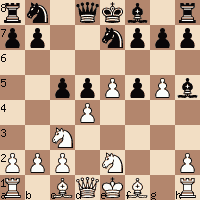
It’s easy to see that White’s position doesn’t make any sense. Not only that, because his center is breaking down, he’s probably lost.
That’s exactly why h4 was an important preparatory move. It allowed White to play the positional pawn sacrifice under the very best circumstances.
10…Nbc6 11.Bf4 Nc8
We’re only on move 11, and Black already has trouble finding natural moves.
12.a3
The Importance of Prophylaxis
Even in great attacking games, we must usually take time to counter our opponent’s threats
It would be ideal if we could make a threat every single move. However, that’s not the true nature of chess… even in great attacking games, we must usually take time to counter our opponent’s threats.
The move 12.a3 stops Black from playing cd, followed by Bb4. This is an equalizing maneuver in several variations of the Advance Caro Kan, and it was best to deprive Black of this active role for his king bishop.
12...Be7 13.Bg2 Nb6 14.dxc5 Bxc5 15.b4 Be7 16.Nxd5 Nxd517.Bxd5 0–0 18.c4
A Valuable Advance on the Queenside
White has recovered his pawn, with a more active position, and a majority on the Queen side. I played c4 for three reasons:
- Mobilize the majority.
- Protect the Bishop.
- Open an active diagonal for my Queen.
18…Re8 19.Rh3
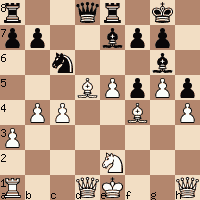
Black was threatening to concentrate pressure on the e pawn, and White is ready to protect it with Re3. Not only that – the rook has great prospects all along the third rank, depending on how the contest unfolds.
19...Qb6 20.Qd3
QUESTION
Why is 20.Qd3 a strong move?
ANSWER
It prepares c5, advancing the majority. The queen wants to control b5, which would be the most active square for Black’s Queen after the pawn advances.
Let’s take a look at the geometry:
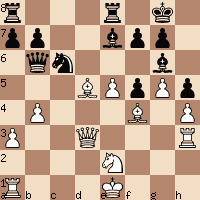
20...Rad8 21.Rd1 a5 22.c5 Qa7 23.Qb3 axb4 24.axb4 Ra8 25.Nd4
The square c6 is suddenly under pressure!!!
This is important because it adds a great deal of value to my light square bishop. After Black captures on d4 his knight pawn becomes very weak. If the knight pawn falls, the win will be easy, with a protected passed pawn on c5. The contest ends with a tactical sequence, as Black tries hard to break out of the box.
However, as might be expected, White ends up with a large advantage.
I’ll create some diagrams to show the geometry involved. Although the tactics are interesting, I won’t make comments, because they distract from the true nature of the contest, and the best lessons have already been learned.
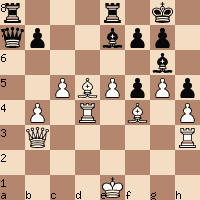
25...Nxd4 26.Rxd4
26…Qa1+ 27.Rd1 Qa4 28.Bxb7 Bxc5
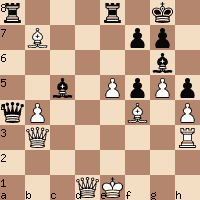
29.Bxa8 Bxb4+ 30.Kf1 Rxa8 31.Rd8+ Kh7 32.Rxa8 Qxa8 33.Qxb4 Qa1+ 34.Kf2 Qa2+ 35.Qd2 Qa7+ 36.Kg2 Qb7+ 37.Kh2
Get the PGN: Positional Pawn Sacrifice Buries Black’s Bishop

i like article